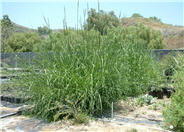
Common name:Ivy Geranium
Botanical name:Pelargonium peltatum
Clouds of single flowers are produced from spring through fall on this perennial, which should be planted in areas that receive protection from afternoon sun in warm inland areas. Ivy geranium reaches 2' tall and spreads to 3' wide. Leaves are shaped like ivy leaves, thus its common name. Flowers bloom from spring through fall in pink, white, red or violet. It looks great in containers as it spills over. Deadhead to encourage more blooming and keep plant bushy.

Common name:Lindheimer's Muhly
Botanical name:Muhlenbergia lindheimeri
Native to Mexico and TX, this stunning clump-forming grass is a winter dormant grass in cold climates, but usually semi-deciduous in mild climates. From the fall into winter emerge the 5' tall upright flower inflorescence, that rise well above the blue- gray foliage. The flowers are at first purple, then mature to a grey color. Best in full sun with regular watering but will tolerate drought and light shade. -Randy Baldwin
San Marcos Growers

Common name:Deer Grass
Botanical name:Muhlenbergia rigens
The Deer Grass is a warm season perennial that forms dense clumps from the base. The spike-like, straw yellow, flower stalks grow 4' tall, creating a striking foundation form in fall. The Deer Grass is native to California and needs watering once or twice a month after it's established. The more water it has, the greener it is.

Common name:Mexican Bush Sage, Mexican Sage
Botanical name:Salvia leucantha
The Mexican Sage is a bushy shrub that grows 3'-4' tall and wide. It has hairy white stems, grey-green leaves and velvet-like purple flower spikes that bloom summer through fall. This shrub tolerates sun, light shade, low to moderate water, and is cold hardy to 15 degrees F. The Mexican Sage attracts hummingbirds. Be careful not to overwater.

Common name:Giant Wild Rye
Botanical name:Leymus condensatus
A prominent, tall native grass that usually does not make its way into traditional residential landscapes but can be used very effectively in a native or natural garden. Reaches heights of 6'-8' in bloom with tan flowers. It spreads vigorously. It needs supplemental water to remain green in the summer. Too much water will cause the grass to decline significantly. Can be pruned annually to promote new, more attractive growth.
| Designer: Robery Boro, Jody Palmer | Walkway to Entry |
Photographer: GardenSoft |
Soils and Compost:
Maintain a two to four inch layer of mulch on the soil surface to reduce weeds, infiltrate rain water, and reduce compaction.
Water Saving Tip:
Fix leaking sprinklers, valves, and pipes.
One broken spray sprinkler can waste 10 gallons per minute - or 100 gallons in a typical 10 minute watering cycle.
Integrated Pest Management:
Remove irrigation water and fertilizer from areas where you don't want weeds to grow.
